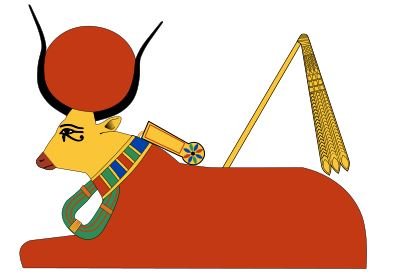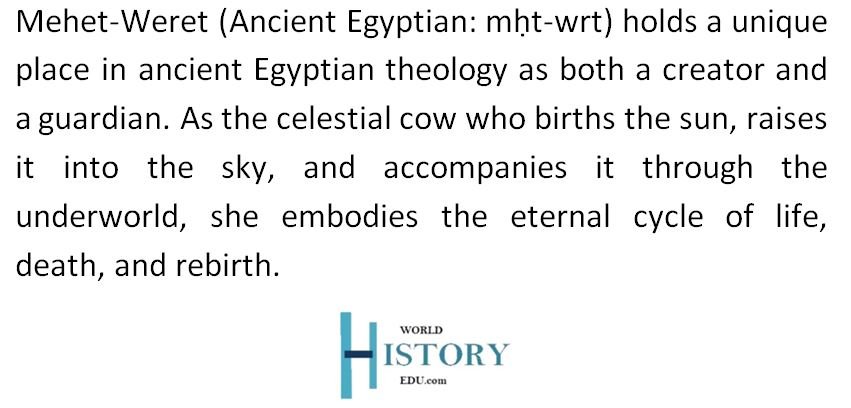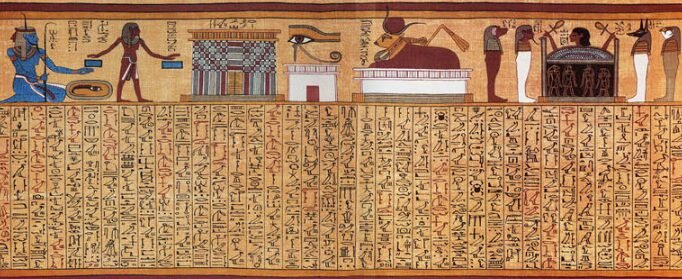How Did Mehet-Weret Shape Ancient Egyptian Beliefs About Creation and Rebirth?
Mehet-Weret, also known as Mehturt, was a prominent celestial goddess in ancient Egyptian mythology. Her name, meaning “Great Flood,” connects her with both cosmic and terrestrial waters. Appearing in some of Egypt’s oldest religious texts, she played a significant role in the mythologies surrounding the sun, the sky, and the cyclical nature of life and death.

A drawing portraying Mehet-Weret
Through her association with solar birth, daily renewal, and cosmic order, Mehet-Weret came to symbolize creative power, divine motherhood, and the eternal journey of the sun across the heavens.
READ ALSO: Mythological Realms in Ancient Egypt
The Role and Symbolism of Mehet-Weret in Egyptian Religion
Mehet-Weret was primarily revered as a sky goddess, closely associated with the waters of the heavens. In the Pyramid Texts, among the earliest religious writings in ancient Egypt, she is identified as the celestial cow from whose body the sky was formed. Her mythic identity is deeply entwined with the daily rebirth of the sun god Ra, making her an essential figure in solar theology. As the divine cow, she was said to give birth to the sun at the dawn of time and again each morning, thus ensuring the continuation of life.
Her name, “Great Flood,” links her symbolically with the annual inundation of the Nile River, which was vital for agricultural fertility. In this context, she was seen as a nourishing force who sustained the natural order and allowed life to flourish. This merging of sky and flood imagery made her a cosmic embodiment of creation, birth, and rejuvenation.

Origins and Mythological Importance
Mehet-Weret’s cosmological function was to lift the sun into the sky every morning. By doing so, she enabled light and warmth to reach the earth, bringing vitality to crops and sustaining human life. In this sense, her presence in myth aligns with other major mother deities, such as Isis, Hathor, and Neith, all of whom share symbolic associations with the Eye of Ra—a manifestation of divine protection and wrath.
In Patricia Monaghan’s The Encyclopedia of Goddesses and Heroines, Mehet-Weret is portrayed as a foundational creative force, not just because she gives birth to Ra but because she enables the world to exist in an ongoing state of rebirth. She is the source of divine continuity in the universe. The connection between Mehet-Weret and the solar cycle underlines her indispensable place in Egyptian cosmology. Each night the sun was believed to journey through the underworld, only to be reborn at dawn—through her agency.
Geraldine Pinch adds another dimension by suggesting that Mehet-Weret may have been conceptualized as the Milky Way itself. This interpretation reinforces her role as a celestial waterway—the path along which the solar barque of Ra traveled. This idea aligns with the ancient Egyptians’ understanding of the sky not as a vacuum but as a fluid space, a watery expanse through which deities sailed.
Iconography and Physical Depiction
In ancient Egyptian art, Mehet-Weret is commonly depicted as a majestic cow or a cow-headed woman. When portrayed as a seated cow, she often bears the golden solar disk between her horns, signifying her connection to Ra and to divine illumination. She sometimes carries or gives birth to a sun disk, reinforcing her role as solar mother. The cow form itself was a sacred animal symbolizing nourishment, fertility, and maternal strength.
One of the most famous artifacts depicting Mehet-Weret is a golden bed discovered in the Tomb of Tutankhamun. The bed’s side panels show star-covered cows identified as Isis-Mehet, revealing the blending of divine identities and roles. This also emphasizes how Mehet-Weret, like many Egyptian deities, could function both independently and as an epithet for other goddesses.
On the sarcophagus of Khonsu, son of Sennedjem—buried in tomb TT1 during the Nineteenth Dynasty—Mehet-Weret appears twice. In these scenes, she is shown as a cow seated upon a dais with a flail rising from her back, a symbol of divine authority. The flail, commonly associated with royal power, denotes her role in maintaining cosmic order. In one depiction, Khonsu bows reverently before her, while in another, a small image of Horus lies at her feet, underscoring her maternal link to solar and royal figures.
Mehet-Weret and the Afterlife
Mehet-Weret’s mythological influence extended into the realm of death and rebirth. She features prominently in Spell 17 of the Book of the Dead, a collection of funerary texts used to guide the deceased through the afterlife. In this spell, she is described as the mother of Ra, born from her celestial body. Her relationship with the sun god symbolizes the soul’s potential for renewal and triumph over death.
The ancient Egyptians believed the sun died each evening and journeyed through the Duat, or underworld, only to be reborn by Mehet-Weret at dawn. In this role, she acted as both protector and midwife, guiding the sun through the darkness and enabling its return. This belief extended to human souls, which were thought to mirror the sun’s cycle in their journey through the afterlife. Thus, Mehet-Weret’s presence in funerary texts was both comforting and powerful—she ensured the possibility of resurrection.
Mehet-Weret iconography, mythological associations, and appearances in funerary texts underline her role as a powerful cosmic mother.
The Book of the Dead was vital to Egyptian religion not only for its prayers and magical incantations but also for the mythological insight it offered. Mehet-Weret’s inclusion illustrates the value placed on her protective and creative powers. Her role as a cosmic mother offered assurance that just as Ra was reborn each day, the soul too could rise from the darkness into eternal light.
Association with Other Goddesses
Mehet-Weret’s characteristics often overlapped with those of other powerful goddesses. She shared significant symbolic territory with Hathor, Isis, and Neith—all of whom were mother figures, protectors of the king, and connected to both fertility and solar imagery. Like these goddesses, Mehet-Weret could be called the “Eye of Ra,” a title designating a fierce, radiant force of protection and divine will.
In some texts, Mehet-Weret does not appear as a standalone deity but rather as an aspect or epithet of these other goddesses. This fluidity is typical of Egyptian religion, where deities often shared roles and merged identities. Mehet-Weret’s role as a cosmic cow, sky bearer, and mother of the sun thus allowed her to serve as a universal maternal figure, woven into many parts of the divine tapestry.
Her titles, such as “mound” and “island,” reflect her role in the primordial landscape of creation. In Egyptian creation myths, the world began as a formless watery abyss called Nun, from which a mound rose to create solid ground. As a representation of that emerging structure, Mehet-Weret signified the first act of creation—the platform from which life could begin.

Influence and Legacy
Although Mehet-Weret was not as widely worshipped in popular temples as some of her counterparts, her presence in mythological and funerary literature indicates a deep reverence for her powers. She was a goddess of beginnings, of transitions, and of the vital bridge between death and rebirth. The recurring image of the celestial cow giving birth to the sun each morning captures the Egyptian belief in continuity, order, and the divine rhythm of the universe.
Her legacy endures in modern studies of Egyptian mythology as a potent symbol of maternal divinity, cosmic harmony, and the interconnectedness of creation and rebirth. Through her solar associations, she linked the heavens with human experience, ensuring the cycle of life was seen as sacred and eternal.
FREQUENTLY ASKED QUESTIONS
What does Mehet-Weret’s name mean, and what does it signify?
Her name means “Great Flood,” symbolizing her role as a life-giving force tied to the cosmic waters and the annual inundation of the Nile, both essential for creation and fertility.

Mehet-Weret, as portrayed from the Papyrus Ani.
What role did Mehet-Weret play in Egyptian creation myths?
She was believed to give birth to the sun god Ra at the dawn of time and each morning, embodying creation, daily renewal, and cosmic order.
How was Mehet-Weret depicted in ancient Egyptian art?
She appeared as a cow or cow-headed woman with a solar disk between her horns, often seated or shown with divine emblems like a flail, reflecting her authority and celestial role.
What was her connection to the Milky Way?
Some scholars suggest she represented the Milky Way, envisioned by Egyptians as a celestial river or sky path for Ra’s solar barque.
How did Mehet-Weret feature in the Book of the Dead?
In Spell 17, she is credited with giving birth to Ra and aiding his rebirth, reinforcing her function in guiding souls through the afterlife and enabling resurrection.
Ships of the Gods in Ancient Egyptian Religion and Mythology
Which goddesses is Mehet-Weret associated with?
She shares attributes with Hathor, Isis, and Neith, and sometimes functions as an epithet for them, especially as the “Eye of Ra.”
What was her significance to daily life and agriculture?
By raising the sun and causing the Nile to flood, she provided light and fertile waters, sustaining agriculture and supporting those who worshipped her.
Why was Mehet-Weret important in funerary beliefs?
As a goddess of rebirth, she symbolized the soul’s journey from death to eternal life, mirroring the sun’s nightly passage and morning return.
























